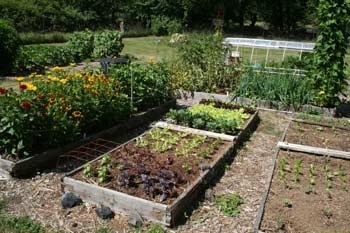Over the past 50 years much of the effort in plant protection, fertilisation and soil amelioration in the garden has been focussed on chemical methods. Pesticides, fungicides, fertilisers and soil wetters have been the mainstay of the home gardener and some of these substances have serious side effects to plants, pets and gardeners.
Research into soil and plant microbiology has been uncovering startling insights into the life above and below the soil that is invisible to the naked eye. Many of the reactions between key groups of microbes are vital to the ongoing health and well being of our prized gardens and if these microbes are nurtured and bolstered with a few simple techniques there can be a massive increase in plant and soil health. Conversely excessive use of chemicals will in time weaken and sterilise the home garden and disrupt is natural ability to defend itself from disease, pests and climatic fluctuations.
Microbes are crucial to soil health. Bacteria, fungi. protozoans and beneficial nematodes all combine to create the Soil Foodweb, the critical interaction of life in the soil that nourishes and protects plants while it improves soil structure and revives your garden.
The main functional groups of soil microbes are as follows:
Bacteria fix nitrogen, attack and consume some fungal diseases, denature toxins, stick microscopic soil particles together and provide food for other important soil and leaf organisms.
Fungi organise soil structure, improve water holding capacity, drainage, reduce soil compaction and dramatically reduce leaching. Fungi also associate with root systems to help with uptake of nutrients and trap and feed on some disease causing organisms
Protozoans feed on bacteria, both harmful and beneficial, leaving plant available nutrients in the root zone after taking the carbon they require.
Beneficial Nematodes feed on bacteria,fungi, and protozoans as well as pathogenic fungi and contribute significantly to nutrient uptake and soil health.
Properly introduced and managed, the Soil Foodweb is the gardener’s most potent tool in the constant struggle to maintain soil and plant health. The Soil Foodweb is at its strongest will:
- Reduce foliar & soil disease pressure
- Improve soil structure & reduce compaction
- Increase nutrient cycling & retention
- Enhance moisture infiltration & retention
- Stimulate root growth
- Optimise crop health, yields & returns
- Reduce Soil Erosion
- Provide natural protection from disease
- Breakdown salts & chemical residues l
- Increase Cation Exchange (CEC) & pH buffering
The most common source of Soil Foodweb organisms is a top quality compost. Good compost has all the microbial assets required to inoculate the soil. Importantly, there have been recent developments in brewing liquid composts or compost teas that enable convenient inoculation of both the soil and leaf surfaces in the garden. This allows plant diseases to be suppressed quickly and effectively in most cases by sheer weight of numbers. Beneficial microbia will colonise plant and soil surfaces and through competition for space, food sources and predation, will curtail disease.
AgriSense Liquid Compost is an actively aerated biological liquid, containing an enormous number and diversity of beneficial organisms, it combines a number of natural products (including kelps, fish products, and organic acids) to maximise its biological potency. In addition to its biological properties AgriSense Liquid Compost introduces a range of plant growth hormones and enzymes to encourage plant growth, and provides a broad range of trace minerals.
AgriSense Liquid Compost provides a preventative approach to managing soil and plant diseases, saving the gardener money and reducing resistance caused by the overuse of agricultural chemicals. AgriSense Liquid Compost inoculates soil and leaf surfaces with beneficial organisms and reduces the ability of pathogens to dominate the soil biosphere while reducing the collateral damage caused by modern fungicides. Repeated applications of AgriSense Liquid Compost combined with the appropriate feeding regime for your crop’s ecological requirement will result in a resilient biomass that will feed and protect your crop, providing it with adequate nutrient and water in conditions that would significantly challenge many crops.
Directions for Use
Excellent for revival and fortification of all soils. Can be sprayed directly on plants to reduce disease. Safe, odourless and completely natural plant and soil stimulant.
This is a living product for best results use within 48 hours of purchase.Use fresh to gain full benefit from the product.
Store in cool dark place.
AgriSense Liquid Compost is an actively aerated compost tea. Oxygen is vital for your microbes. A small aquarium aerator will maintain air for your Liquid Compost if you wish to keep it for a day or two more than the preferred 48 hours stipulated on the label for best effect. If you are keeping it for a while, put it on air immediately.
Rates for Soil Drench
1 litre per 100 square metres in enough water to cover the area you wish to treat. Water in well. Apply with watering can, hose fertilizer mixer or backpack sprayer.
Use in low light and temperature, late afternoon is best: early morning is also good. Can be applied in light rain.
Mix with rain water if possible. Allow chlorinated water to degas under aeration or with a small application of Humic Acid 1 ( gram per litre) before mixing. Leaving overnight in an open tub will reduce chlorine in town water.
Foliar Spray
500 mils will treat 100 square metres. Can be mixed with AgriSense Fish Hydrolysate to aid
spreading and sticking. Use enough water to allow coverage.
Spray early morning, late evening or on overcast days.
Rain fast in 2 hrs
Frequency of Application
Apply monthly throughout the year. When using to combat disease apply more regularly.
Feeding
The biology in your soil will respond to simple foods. After inoculation with liquid compost feed garden with Molasses at 50 mils per 100 square meters, Humic Acid at 50 mils per 100 square meters and Fish Hydrolysate at the same rate. This will activate and multiply your soil biology and allow your sol biology to thrive. These components can be mixed together with Liquid Compost for convenience of application and should be applied monthly.
Wash spraying equipment after use and do not use in sprayers containing fungicides
Please wash and re-use your container
Caution
This liquid is not suitable for ingestion. Keep out of reach of Children and wash hands prior to handling food. If swallowed seek medical advice.
MANUFACTURED BY AGRISENSE PO BOX 532 BELLINGEN NSW 2454 ABN 30 918 904 412 MOBILE 0409185680 2/16 Bayldon Dr Raleigh NSW 2454
2/16 Bayldon Dr Raleigh NSW 2454
 0409185680
0409185680
